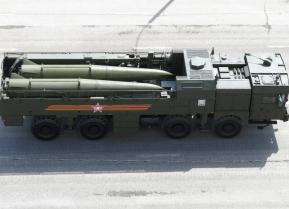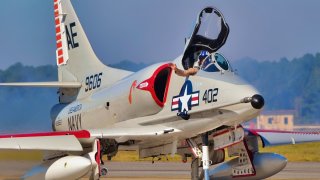The Unstoppable Legacy of the A-4 Skyhawk
The Douglas A-4 Skyhawk is a Cold War-era jet-powered light attack aircraft renowned for its service with the U.S. Navy and Marine Corps, as well as multiple foreign militaries. First flown in 1954 and entering service in 1956, the A-4 was notable for its compact size, agility, and versatility.
What You Need to Know: The Douglas A-4 Skyhawk is a Cold War-era jet-powered light attack aircraft renowned for its service with the U.S. Navy and Marine Corps, as well as multiple foreign militaries. First flown in 1954 and entering service in 1956, the A-4 was notable for its compact size, agility, and versatility.
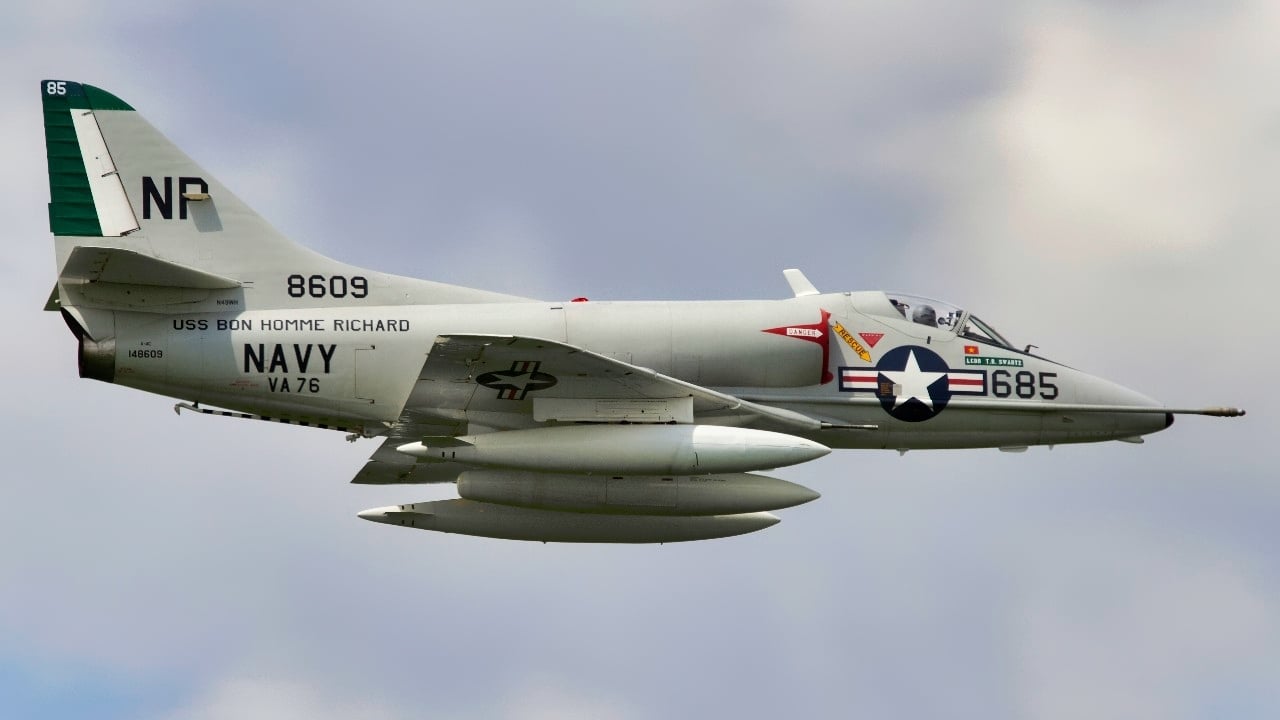
-It played significant roles in conflicts like the Vietnam War, where it was the first aircraft to drop ordnance and logged more missions than any other naval attack aircraft. The Skyhawk was also used effectively by Israel during the Yom Kippur War and by Argentina in the Falklands War.
-Remarkably, the A-4 remains in active service with the Argentine Air Force and the Brazilian Navy, showcasing its enduring legacy.
To an ornithologist, the word “Skyhawk” may seem a bit redundant, since all hawks are birds of prey that swoop down upon their prey.
Be that as it may, “Skyhawk” became the name of a historically significant Cold War-era jet-powered light combat aircraft that kicked butt and took names for the U.S. Navy and Marine Corps as well as multiple foreign militaries. Say hello to the Douglas A-4 Skyhawk.
A-4 Skyhawk Early History & Specifications
The A-4 Skyhawk made her maiden flight on June 22, 1954, and entered into official operational service with the U.S. Navy on October 1, 1956. She was built by the Douglas Aircraft Corporation (which later merged into McDonnell Douglas, which in turn merged into Boeing), a company that was also famous for the SBD Dauntless dive bomber of World War II and the A-1 Skyraider prop-driven fighter that served faithfully in Korea and Vietnam.
The warbird (specifically the A4D-5/A-4E variants) had the following specifications and vital stats:
Fuselage Length: 40 ft 1.5 in.
Wingspan: 27 ft 6 in (8.38 m)
Height: 15 ft 2 in (4.62 m)
Empty Weight: 9.853 lbs. (4,469 kg)
Max Takeoff Weight: 24,500 lbs. (11,100 kg)
Powerplant: one x 8,500 lb. (38 kN) static thrust Pratt & Whitney J52-P-6A engine
Max Airspeed: Mach 0.87 (585 kn; 673 mph; 1,083 km/h)
Range: 1,008 nmi (1,160 mi; 1,867 km)
Armament:
two x 20 mm (0.79 in) Colt Mk 12 cannon
five x hardpoints with a capacity of up to 8,200 lb. of ordnance, such as:
-sixteen x Mk 32 Zuni rockets
-six x Rockeye-II Mk 20 Cluster Bomb Units (CBUs)
-four x AIM-9 Sidewinder infrared (heat-seeking) air-to-air missiles
-two x AGM-12 Bullpup radio-guided air-to-ground missiles
-two x AGM-45 Shrike anti-radiation missiles
A total of 2,960 A-4s were built.
Operational Performance/Combat History Part I: American A-4s
The Skyhawk made history for the U.S. Armed Forces in multiple ways:
-She was the first aircraft to drop ordnance in the Vietnam War, occurring on August 5, 1964, during the Gulf of Tonkin Incident.
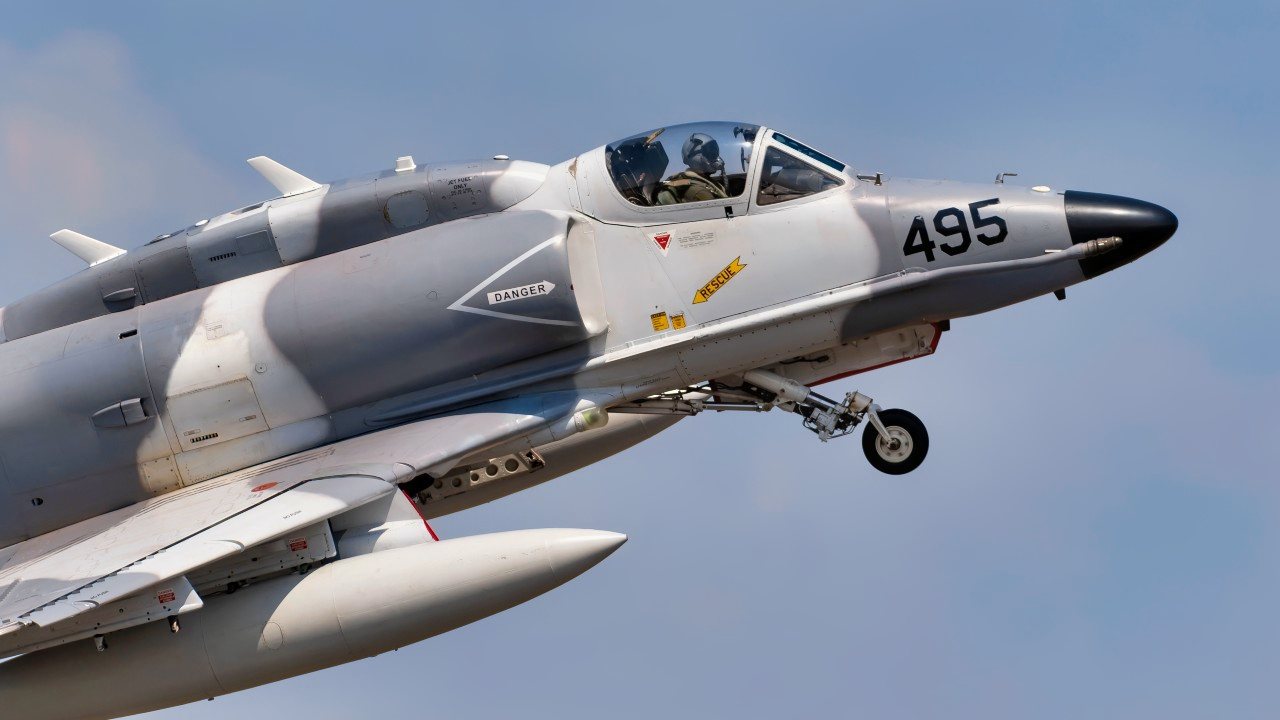
-In that same incident, then-Lieutenant Everett Alvarez was shot down and captured, becoming the second longest-held U.S. prisoner of the war (after his repatriation, he continued with his military career and eventually retired from the Navy at the rank of commander).
-She logged more Vietnam combat missions than any other naval attack aircraft, more than the A-6 Intruder or the A-7 Corsair II.
-She was the warbird flown by eventual U.S. senator and 2008 Republican presidential nominee John McCain on the day of his shootdown that resulted in his harrowing five-and-a-half-year experience as a prisoner of war in the infamous Hanoi Hilton.
-She was the plane flown by U.S. Marine Corps (USMC) captain James Walsh, the last Marine to be taken prisoner during the Vietnam War.
-She was flown by the Blue Angels from 1973 to 1986.
The Skyhawk was retired by the USMC in 1998, with the USN following suit in 2003.
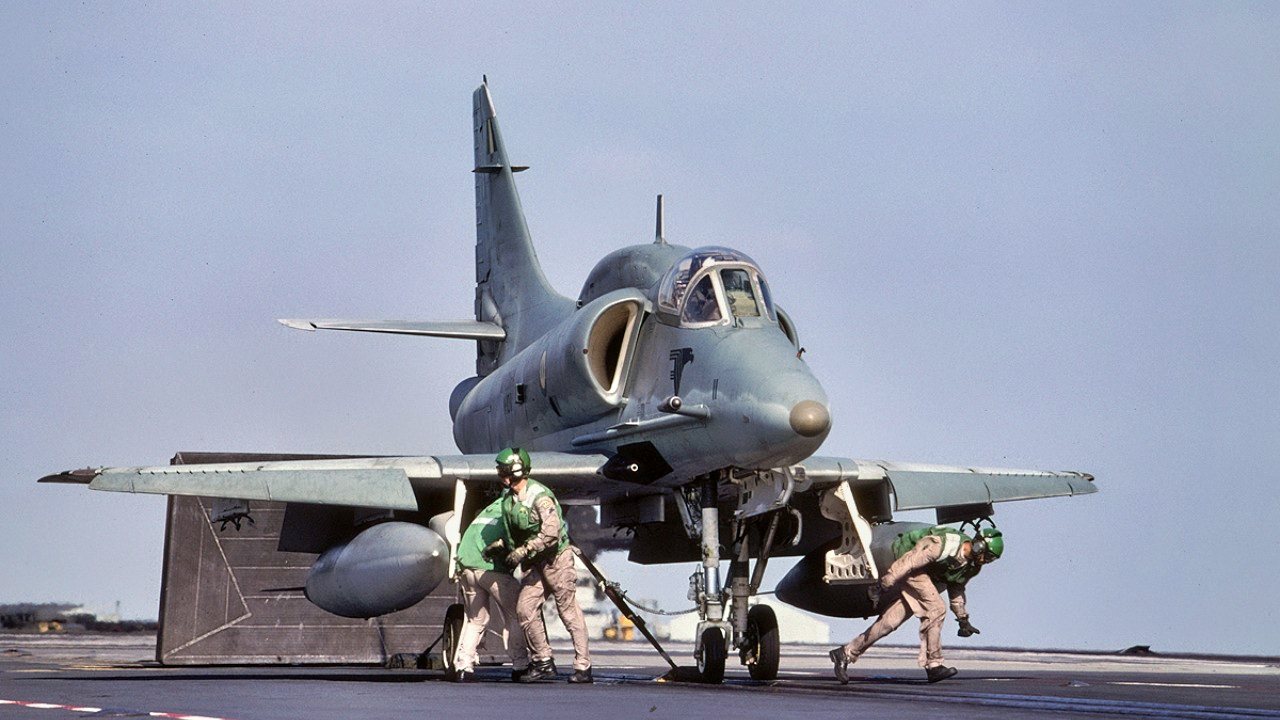
Operational Performance/Combat History Part: Skyhawks as Foreign Fighters
The Skyhawk also performed impressively in the hands of multiple foreign militaries:
-The Israeli Air Force (IAF), which lovingly renamed the plane the “Ayit” (Eagle), was the largest export customer of the A-4 and made heavy use of the warbird during the 1973 Yom Kippur War. In one engagement, an Ayit driver found himself facing three MiG-21 “Fishbeds,” and the IAF pilot skillfully maneuvered his A-4 and shot down two of them, and was reportedly on the third Fishbed’s tail when an IAF Mirage IIIC pilot blasted the MiG out of the sky.
-In a losing effort during the 1982 Falkland Islands War against Great Britain, the Argentine Air Force (the first foreign buyer of the A-4) pulled off numerous feats in their Skyhawks, including the sinking of the HMS Coventry; however, the Argentine Skyhawk drivers didn’t fare so well in aerial combat against the Fleet Air Arm’s Sea Harriers.
-The last nation to use the Skyhawk in major combat operations was Kuwait, during the 1990-1991 Persian Gulf War. In response to Saddam Hussein’s initial invasion of their tiny country in August 1990, Kuwaiti Air Force pilots strafed an Iraq armored column of the al-Medinah al-Munawera Division and shot down three Iraqi helicopters. Subsequent to the occupation, “Free Kuwaiti Air Force” A-4s operating out of Saudi Arabia flew 1,361 sorties during the liberation of their country.
Where Are They Now?
Amazingly enough, the A-4 remains in service with: the Argentine Air Force, specifically the A-4AR/OA-4AR variant, which has been redubbed the Fightinghawk; and the Brazilian Navy. The World Directory of Modern Military Aircraft notes that the Argentines have twenty-three A-4ARs in the fighter/attack role and three OA-4ARs in the fighter/trainer role. As for the Brazilians, they have five single-seater and two two-seater specimens, which they have redubbed the AF-1B and AF-1C respectively; these have been modernized and upgraded by Embraer.
Meanwhile, Skyhawks have been preserved for posterity in either airworthy shape or as static displays in at least ten different countries. To cite just a couple of the latter option for the benefit of my fellow museum lovers out there, there’s the National Naval Aviation Museum at Naval Air Station (NAS) Pensacola in Florida (I can personally vouch for this museum) and the Estrella Warbirds Museum in Pasa Robles, California.
As for a few examples of airworthy stateside Skyhawks, for starters, there’s Navy Bureau Number (BuNo) 148609 at the Warbird Heritage Foundation in Waukegan, Illinois. Meanwhile, Draken International, LLC of Lakeland, Florida has thirteen of the birds, whilst A-4L, LLC (AKA The Skyhawk Association AKA Sky Resources) owns seven and currently operates three, which are based at North Texas Regional Airport/Perrin Field (ICAO: KGYI) in Denison, Texas.
About the Author:
Christian D. Orr is a Senior Defense Editor for the National Security Journal (NSJ). He is a former Air Force Security Forces officer, Federal law enforcement officer, and private military contractor (with assignments worked in Iraq, the United Arab Emirates, Kosovo, Japan, Germany, and the Pentagon). Chris holds a B.A. in International Relations from the University of Southern California (USC) and an M.A. in Intelligence Studies (concentration in Terrorism Studies) from American Military University (AMU). He has also been published in The Daily Torch, The Journal of Intelligence and Cyber Security, and Simple Flying. Last but not least, he is a Companion of the Order of the Naval Order of the United States (NOUS).
Image Credit: Creative Commons.
